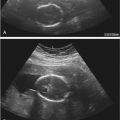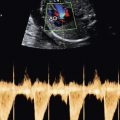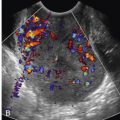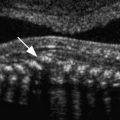Outline
Ultrasound Examination Techniques, 653
Limitations and Pitfalls, 656
Full Bladder, 656
Excessive Pressure, 656
Contraction, 656
Underdeveloped Lower Uterine Segment, 656
Clinical Applications, 657
Transvaginal Ultrasound of the Cervix for Prediction of Preterm Birth, 657
Dynamic Changes (Spontaneous or After Transfundal Pressure), 660
Normal Versus Abnormal Cervical Length, 660
Best Gestational Age and Frequency of Examinations, 661
Populations, 661
Singleton Without Prior Spontaneous Preterm Birth (Low Risk), 663
Singleton With a Prior Spontaneous Preterm Birth (High Risk), 664
Women With Cerclage, 664
Women With Pessary, 664
Twins, 665
Triplets, 665
Three-Dimensional Transvaginal Ultrasound Examination of the Cervix, 665
What Pathophysiologic Mechanisms Associate a Short Cervical Length With Preterm Birth?, 666
Clinical Use of Cervical Length for Prevention of Preterm Birth, 667
Asymptomatic Singletons Without Prior Spontaneous Preterm Birth, 667
Asymptomatic Singletons With Prior Spontaneous Preterm Birth, 668
Asymptomatic Multiple Gestations, 668
Preterm Labor, 669
Preterm Premature Rupture of the Membranes, 669
Prediction of Start of Spontaneous Labor, 669
Predicting the Success of Labor Induction and Mode of Delivery, 670
Conclusions, 670
Summary of Key Points
- •
Transvaginal ultrasound (TVU) for cervical assessment is one of the best techniques for predicting preterm birth (PTB).
- •
A cervical length (CL) of less than 25 mm between 16 and 24 weeks’ gestation is the most reliable threshold for an increased risk of PTB.
- •
The shorter the cervix and the earlier in gestation the shortening occurs, the higher the risk of PTB.
- •
TVU is the gold standard for ultrasound cervix measurements because a short cervix can be missed on transabdominal scans.
- •
Appropriate technique is key to accurate TVU measurement of CL.
- •
With a dynamic cervix, or in the presence of funneling, practitioners should report the shortest optimally imaged transvaginal ultrasound measurement of closed CL as the one single measurement to guide clinical decisions.
- •
The same transvaginal CL has very different positive predictive values depending on the a priori individual patient characteristics.
- •
The predictive value of sonographic CL determination in twins between 24 and 34 weeks’ gestation is low.
Ultrasound assessment of the cervix during pregnancy has become an essential part of modern clinical care. Significant advances have been made in understanding the proper role of this sonographic screening test. In this chapter we will review the technique of transvaginal cervical assessment and discuss its expanding role in clinical practice.
Ultrasound Examination Techniques
Transabdominal Ultrasound
In the 1970s, the first attempts at evaluating the cervix used transabdominal ultrasound (TAU). Unfortunately, this technique has relatively poor reliability and validity because of the following shortcomings: (1) the bladder often needs to be adequately filled to obtain a good image, resulting in elongation of the cervix and masking of any funneling of the internal os; (2) fetal parts can obscure the cervix, especially after 20 weeks; (3) the distance from the probe to the cervix results in degraded image quality; and (4) obesity and manual pressure interfere with the resulting image. Therefore, it is generally suggested that TAU should not be used for assessment of the cervix, even as a screening test, because its sensitivity for prediction of disease (e.g., increased risk for PTB) is unacceptably low (8%) in comparison to TVU. All randomized controlled trials (RCTs) that proved benefit with different treatments for a sonographically detected short cervix used TVU: vaginal progesterone, cerclage, and pessary. The sensitivity of TVU has been shown to be significantly higher than TAU in detecting a short cervix ( Table 18-1 ).
| Study * | GA, Week (Mean) | N (TVU CL < 25 mm) | Bladder | Blind | TAU Cutoff (mm) | TA Variation (Longer/Shorter) | Sensitivity | Need TVU (TAU Not Obtainable) |
|---|---|---|---|---|---|---|---|---|
| Saul et al, 2008 | 14-34 (22) | 191 (14) | Postvoid | Yes | ≤30 | Same | 100% | NA |
| Stone et al, 2010 | 18-20 | 203 | Postvoid | No | NA | Shorter | NA | NA |
| To et al, 2000 | 22-24 (23) | 149 | Prevoid | NA | NA | NA | NA | NA (51%) |
| Hernandez-Andrade et al, 2012 | 6-39 (24) | 220 (20) | Prevoid | Yes | ≤25 ≤30 | Longer | 43% 57% | NA |
| Friedman et al, 2013 | 18-24 (20.5) | 1217 (76) | Prevoid Postvoid | No | ≤36 ≤36 | Shorter | 96% 96% | 60% (6%) NA (17%) |
* These studies are listed in the references at the end of the chapter.
As can be seen from the studies described in Table 18-1 , it is still unclear if TAU is better done before or after voiding; only two studies report blind results. The cutoff for TAU-detected CL measurement needs to be high (usually >35 mm) to achieve a sensitivity of more than 90% for a shortened cervix by TVU, in which case most patients screened with TAU would need a subsequent TVU to confirm or rule out a short cervix. In 9% to 51% of attempted TAU, CL was not obtainable. Moreover, TVU CL screening has been shown to have superior cost-effectiveness compared to TAU, with TVU associated with slightly better prevention of PTB, resulting in cost savings of millions of dollars. All major guidelines that have described CL screening have clearly recommended TVU, including the Society for Maternal-Fetal Medicine (SMFM), the American College of Obstetricians and Gynecologists (ACOG), and the Royal College of Obstetricians and Gynaecologists. Given the preponderance of the evidence, TAU is less effective than TVU and should not be used for CL screening.
Translabial Ultrasound
Translabial (also known as transperineal) ultrasound (TLU) was first described in France in the early 1980s. This technique involves having the woman lie on the examination table with her hips and knees flexed. Adjusting the examination table to place her in a Trendelenburg position can be helpful. A covered transducer (using a probe cover, or glove, and sterile gel) is positioned in a sagittal orientation on the perineum between the labia majora at the level of the vaginal introitus ( Fig. 18-1 ). Elevation of the woman’s hips with a cushion or by positioning her hands to achieve a pelvic tilt can be used to improve visualization. Unlike TAU, this technique does not require bladder filling, is not impaired by obscuration by fetal parts, and with the transducer closer to the cervix, achieves close to 100% visualization. Other advantages of this technique are that the transducer does not enter the vagina (so no pressure can be exerted on the cervix thus no alteration in appearance from mechanical effect), it does not require an additional transducer, it can be performed in the setting of ruptured membranes, and it is well accepted by most women. The main drawback of TLU, however, is that gas in the rectum sometimes impedes visualization of the cervix, especially the external os. TLU is also more difficult to master than TVU and has been reported to be an unsatisfactory alternative. However, with experience in using TLU, adequate visualization of the cervix can often be obtained.

Transvaginal Ultrasound
The first studies of the human cervix using TVU date back to the late 1980s. A clean transvaginal probe covered by a condom is gently inserted into the vagina ( Fig. 18-2A and B ). The technique shares the advantages of TLU; however, the probe is close to the cervix, without the problem of obscuring bowel gas. Thus, TVU has become the preferred approach for sonographic evaluation of the gravid cervix in virtually all clinical settings ( Fig. 18-3A to C ). Current recommendations for the performance of TVU of the cervix are shown in Table 18-2 .


|
The total time for TVU of the cervix is approximately 5 minutes. For optimal results, the following criteria should be sought: the internal os should be either flat or at an isosceles angle with respect to the uterus, the whole length of the cervix should be visualized, a symmetric image of the external os should be obtained, the distance from the surface of the posterior lip to the cervical canal should be equal to the distance from the surface of the anterior lip to the cervical canal, and there should be no increased echogenicity in the cervix (a sign of excessive pressure).
Successful completion of the education program, examination, and continuing image review, all provided by the Perinatal Quality Foundation of the SMFM, is available and is recommended. Ideally, TVU CL assessment should only be performed after this program has been completed.
Limitations and Pitfalls
Although TVU of the cervix is usually straightforward, an anatomic or technical difficulty is encountered in approximately one fourth of patients.
Full Bladder
A bladder that is not completely empty of urine can exert pressure on and appear to elongate the cervix or might mask funneling or opening of the internal os.
Excessive Pressure
Excessive pressure by the examiner with the transvaginal transducer can also mask funneling or opening of the internal os and can elongate the cervix. This can be recognized by alterations in appearance including asymmetry in thickness of the anterior and posterior walls of the cervical canal and by increased echogenicity of the cervix ( Fig. 18-4 ).

Contraction
Uterine segment contractions may mimic the appearance of funneling of the internal cervical os. In such cases, there is rounded myometrium around the cervix and a normal cervix distal to the contraction ( Fig. 18-5 ).

Underdeveloped Lower Uterine Segment
Before 14 weeks, the lower uterine segment is difficult to distinguish from the endocervical canal, because the gestational sac has not reached a sufficient size to completely expand the lower part of the uterus. Therefore, the measurement of the true CL is difficult before 14 weeks. At other times, particularly between 14 and 18 weeks’ gestation, the presence of a contraction can close the lower uterine segment and make the distinction between this structure and the true CL difficult.
Clinical Applications
Transvaginal Ultrasound of the Cervix for Prediction of Preterm Birth
Screening Test Criteria
TVU of the cervix is most often used in obstetrics as a screening test for the prediction of PTB. To be clinically beneficial, a screening test must fulfill specific criteria ( Table 18-3 ).
| Characteristic of Screening Test | Comments |
|---|---|
| Disease | |
| Disease is clinically important | PTB: 1 million deaths annually worldwide |
| Disease is clearly defined | Birth < 37weeks |
| Disease prevalence is well known | 11.5% in United States; about 10% worldwide |
| Disease natural history is known; recognizable early asymptomatic phase | First cervical changes occur at the internal os |
| Screening | |
| Screening technique well described | Several articles |
| Screening is safe and acceptable | RCT on PPROM showing safety ; 99% would have it again; <2% experience severe pain |
| Screening has a reasonable cutoff identified | 20 mm is the 5th percentile, 25 mm is the 10% percentile in the general U.S. population |
| Results are reproducible (reliable) | <10% intraobserver and interobserver variability |
| Results are accurate (valid) | Better than manual examination; predictive in all populations studied (hundreds of studies) |
| Intervention, Cost-Effectiveness, and Feasibility | |
| “Early” intervention is effective | Two RCTs for vaginal progesterone ; five RCTs for cerclage |
| Screening and treating abnormal findings is cost-effective | Two cost-effectiveness manuscripts published |
| Facilities for screening are readily available | All pregnancies are offered a sonogram for fetal anatomy screening at around 18-24 weeks |
| Facilities for treatment are readily available | Vaginal progesterone is easily administered on an outpatient basis |
Important and Prevalent Condition.
First, a good screening test must evaluate for a clinically important and prevalent condition. PTB occurs in 11.5% of births, or approximately 500,000 pregnancies, per year in the United States alone. It is the leading cause of perinatal morbidity and fatality in the United States and as such may be the most important pathologic condition in obstetrics. In terms of years of life lost, PTB is one of the most important diseases in all of medicine.
Technique Well Described.
The technique is well described (see Table 18-2 ).
Safe and Acceptable.
TVU of the cervix is very safe. There is no inoculation of bacteria with TVU. In a randomized trial comparing the use of TVU or the nonuse of TVU in the presence of premature preterm rupture of membranes (PPROM), there was no increased risk of infection for mother or fetus with TVU of the cervix compared with no TVU of the cervix. TVU is also well accepted by pregnant women. Pain and severe discomfort are experienced by fewer than 2% of women undergoing TVU, and more than 99% of women would agree to a similar procedure in the future.
Reliable/Reproducible.
The interobserver and intraobserver variability scores of TVU are both less than 10%. This low variability between operators is achieved only after adequate training with supervised scans and with strict adherence to proper technique, as described earlier.
Recognizable Early Asymptomatic Phase.
The changes of the cervix that are associated with preterm or term labor have been demonstrated by TVU. These changes include initial opening of the internal os, progressive cervical shortening and widening along the endocervical canal from the internal to the external os, and ultimate opening of the external os. The earliest changes at the internal os are almost always asymptomatic and can be detected only by TVU.
Accuracy of Prediction: Valid Comparison With Manual Examination of the Cervix.
Cervical assessment by manual (digital) examination was a traditional method for prediction of PTB. Digital and transvaginal ultrasound examinations of CL every 2 weeks from 14 to 30 weeks’ gestation were compared in one study (with examiners blinded to the results of the alternate technique) and found to both independently predict PTB, but TVU had a much stronger association with PTB than manual examination of the cervix. The mean sonographic CL of the PTB group was significantly shorter than that of the term delivery group, whereas there was no difference in manual cervical measurements between the two groups.
The relative lack of success of the digital examination in predicting PTB is probably due to the fact that it is subjective (interobserver variability of 52%), not accurate for evaluating the internal os (the upper half of the cervix is not measurable by this method), and nonspecific (15% to 16% of primiparous women and 17% to 35% of multiparous women who are delivered at term have cervices that are 1 cm to 2 cm dilated by manual examination in the late second trimester). Sonographic CL measurements are, on average, 11 mm longer than manual estimations. The majority, about three fourths, of asymptomatic women with funneling of the internal os have a cervix felt to be closed and at least 2 cm long by manual examination. These data demonstrate clear benefits of TVU over manual examination for evaluation of the cervix and prediction of PTB.
Measurements
Cervical Length.
Different cervical parameters have been evaluated as predictors of PTB ( Fig. 18-6 ). CL, as measured from the internal to the external os along the endocervical canal, is the most reproducible and reliable measurement ( Figs. 18-2B and 18-7A and B ). If the cervical canal is curved, defined as a deviation of the canal of more than 5 mm, the CL can be preferably measured as the sum of two straight lines that essentially follow the curve ( Fig. 18-7C ). A short CL is usually straight, whereas the presence of a curved cervix generally signifies a CL of more than 25 mm and, therefore, is a reassuring finding. If the cervical canal is closed, CL is the only parameter that needs to be measured.


Funneling.
In about 10% of low-risk women and 25% to 33% of high-risk women, the internal os is open ( Fig. 18-8 ). In this case, the open portion of cervix (funnel length) and internal os diameter (funnel width) can be measured. The percentage of funneling is calculated as funnel length divided by total CL. Total CL is equivalent to the sum of funnel length and functional CL. Functional CL in this case is the closed portion of the endocervical canal only. Functional CL is the sonographic CL used for calculations and predictions, and the term CL, if not otherwise specified, refers to the functional CL.

If funneling is present, the shape can be recorded. A continuous process of funneling has been described, going from a normal T shape, to Y, then V, and finally a U shape ( Figs. 18-9 and 18-10 ). It appears that U-shaped funneling is more likely to be associated with PTB compared with a V-shaped funnel ; however, these distinctions are somewhat subjective.
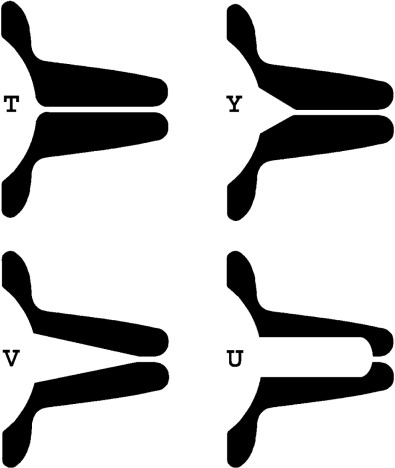

Careful evaluation of the apparent funneling with TVU over several minutes (at least 5) should resolve any question of the morphologic character of the upper cervical canal. In some instances, the depth of a true funnel may be difficult to quantify, because the funneled portion may merge with the lower uterine segment and the characteristic shoulder that depicts the border between lower uterine segment and the true cervix may be flattened. Funneling has been reported to have higher interobserver variability among examiners and different centers than CL.
In spite of these difficulties, funneling has been reported to have better or similar predictive accuracy for PTB than CL. In one high-risk population, minimal funneling (<25%) noted between 14 and 22 weeks was not associated with a significant increase in PTB, whereas moderate funneling (25-50%) and severe funneling (>50%) were associated with a 50% or more probability of PTB. The fact that less than 25% funneling is not associated with an increased risk of PTB is important, because this is a common finding that should not raise alarm or result in intervention. Funneling has been shown in all studies, not just those focused on high-risk pregnancies, to predict PTB. If funneling is present, the CL is almost always short (<25 mm). In the presence of a short CL, the presence of funneling may or may not add to the prediction of PTB or adverse perinatal outcome. Compared with a CL less than 25 mm alone, adding funneling can increase the sensitivity for PTB (from 61-74%) without major changes in specificity, and positive and negative predictive values. In addition, the risk of PTB is higher if both a short CL and funneling are detected, compared with a short CL without funneling. On the contrary, the presence of funneling in a woman with a normal (≥25 mm) CL does not seem to increase her risk of PTB (see funnel Y in Fig. 18-9 ).
Given these shortcomings, as well as the fact that almost all intervention trials are based on TVU-detected CL (TVU-CL) alone, we do not recommend recording funneling on ultrasound reports. Following this recommendation will help to avoid confusion, as only CL is needed for clinical care.
Sludge.
Free-floating echogenic material within the amniotic fluid has been referred to as sludge, or debris. Sludge has been proved to be an independent risk factor for PTB, microbial invasion of the amniotic cavity, and histologic chorioamnionitis. There are, however, no studies on interventions specific to intra-amniotic sludge or to prevent its consequences when present.
Other Measurements.
Many parameters other than CL and the presence or absence of a funnel have been studied in relation to PTB, including funnel width, funnel length, endocervical canal dilatation, cervical index (funnel length + 1/functional length), anterior and posterior cervical width, cervical angle, cervical canal contour (straight versus curved), cervical position (horizontal versus vertical), lower uterine segment thickness, vascularity, visibility of chorion-amnion membranes at the internal os, cervical gland area, quantitative tissue characterization, and others. None of these parameters has proved more reliable or predictive than CL. Additionally, there is insufficient evidence to assess if the addition of any of these parameters improves the predictive accuracy already provided by CL. Several other measurements may be taken in the presence of a cerclage ( Figs. 18-11 through 18-14 ). Although some of these measurements may be predictive of PTB, TVU-CL alone should be reported in all populations in which TVU for prediction of PTB is performed.






